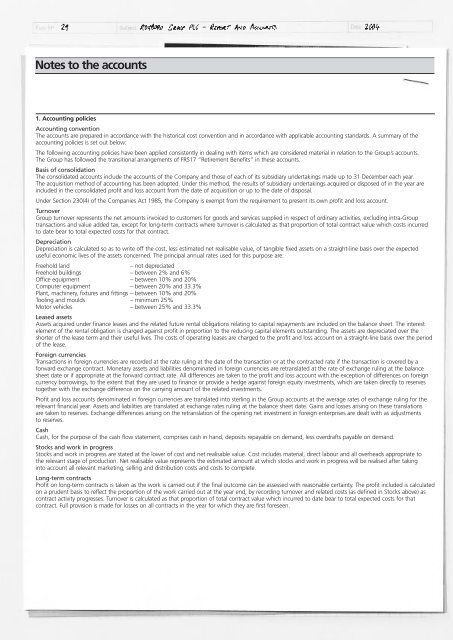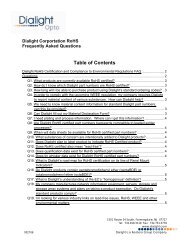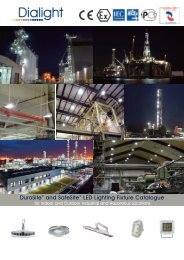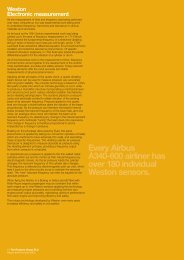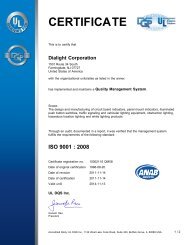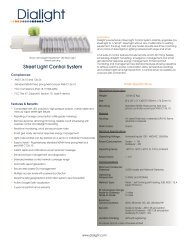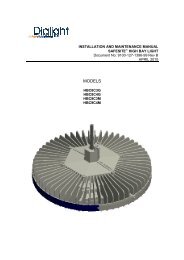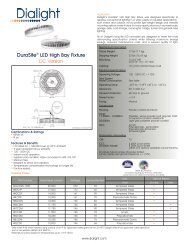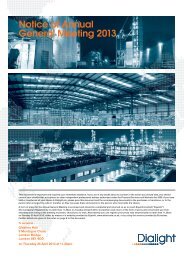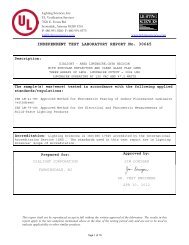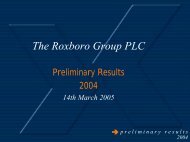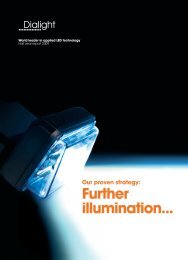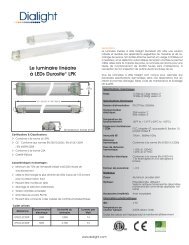Prod Roxboro R&A 2004 - Back - Dialight
Prod Roxboro R&A 2004 - Back - Dialight
Prod Roxboro R&A 2004 - Back - Dialight
- No tags were found...
Create successful ePaper yourself
Turn your PDF publications into a flip-book with our unique Google optimized e-Paper software.
Notes to the accounts1. Accounting policiesAccounting conventionThe accounts are prepared in accordance with the historical cost convention and in accordance with applicable accounting standards. A summary of theaccounting policies is set out below:The following accounting policies have been applied consistently in dealing with items which are considered material in relation to the Group’s accounts.The Group has followed the transitional arrangements of FRS17 “Retirement Benefits” in these accounts.Basis of consolidationThe consolidated accounts include the accounts of the Company and those of each of its subsidiary undertakings made up to 31 December each year.The acquisition method of accounting has been adopted. Under this method, the results of subsidiary undertakings acquired or disposed of in the year areincluded in the consolidated profit and loss account from the date of acquisition or up to the date of disposal.Under Section 230(4) of the Companies Act 1985, the Company is exempt from the requirement to present its own profit and loss account.TurnoverGroup turnover represents the net amounts invoiced to customers for goods and services supplied in respect of ordinary activities, excluding intra-Grouptransactions and value added tax, except for long-term contracts where turnover is calculated as that proportion of total contract value which costs incurredto date bear to total expected costs for that contract.DepreciationDepreciation is calculated so as to write off the cost, less estimated net realisable value, of tangible fixed assets on a straight-line basis over the expecteduseful economic lives of the assets concerned. The principal annual rates used for this purpose are:Freehold land– not depreciatedFreehold buildings – between 2% and 6%Office equipment – between 10% and 20%Computer equipment – between 20% and 33.3%Plant, machinery, fixtures and fittings – between 10% and 20%Tooling and moulds – minimum 25%Motor vehicles – between 25% and 33.3%Leased assetsAssets acquired under finance leases and the related future rental obligations relating to capital repayments are included on the balance sheet. The interestelement of the rental obligation is charged against profit in proportion to the reducing capital elements outstanding. The assets are depreciated over theshorter of the lease term and their useful lives. The costs of operating leases are charged to the profit and loss account on a straight-line basis over the periodof the lease.Foreign currenciesTransactions in foreign currencies are recorded at the rate ruling at the date of the transaction or at the contracted rate if the transaction is covered by aforward exchange contract. Monetary assets and liabilities denominated in foreign currencies are retranslated at the rate of exchange ruling at the balancesheet date or if appropriate at the forward contract rate. All differences are taken to the profit and loss account with the exception of differences on foreigncurrency borrowings, to the extent that they are used to finance or provide a hedge against foreign equity investments, which are taken directly to reservestogether with the exchange difference on the carrying amount of the related investments.Profit and loss accounts denominated in foreign currencies are translated into sterling in the Group accounts at the average rates of exchange ruling for therelevant financial year. Assets and liabilities are translated at exchange rates ruling at the balance sheet date. Gains and losses arising on these translationsare taken to reserves. Exchange differences arising on the retranslation of the opening net investment in foreign enterprises are dealt with as adjustmentsto reserves.CashCash, for the purpose of the cash flow statement, comprises cash in hand, deposits repayable on demand, less overdrafts payable on demand.Stocks and work in progressStocks and work in progress are stated at the lower of cost and net realisable value. Cost includes material, direct labour and all overheads appropriate tothe relevant stage of production. Net realisable value represents the estimated amount at which stocks and work in progress will be realised after takinginto account all relevant marketing, selling and distribution costs and costs to complete.Long-term contractsProfit on long-term contracts is taken as the work is carried out if the final outcome can be assessed with reasonable certainty. The profit included is calculatedon a prudent basis to reflect the proportion of the work carried out at the year end, by recording turnover and related costs (as defined in Stocks above) ascontract activity progresses. Turnover is calculated as that proportion of total contract value which incurred to date bear to total expected costs for thatcontract. Full provision is made for losses on all contracts in the year for which they are first foreseen.


